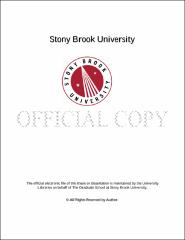| dc.identifier.uri | http://hdl.handle.net/11401/77763 | |
| dc.description.sponsorship | This work is sponsored by the Stony Brook University Graduate School in compliance with the requirements for completion of degree. | en_US |
| dc.format | Monograph | |
| dc.format.medium | Electronic Resource | en_US |
| dc.language.iso | en_US | |
| dc.publisher | The Graduate School, Stony Brook University: Stony Brook, NY. | |
| dc.type | Thesis | |
| dcterms.abstract | Microcystis is one of the most common and frequently occurring cyanobacteria that cause harmful algal blooms in the world. Incidences and toxicity of blooms have been increasing in recent decades, a trend that is likely to continue due to anthropogenic actions, thus making characterization of effects important for predicting outcomes. Aquatic organisms are at a high risk for toxic effects, and early life stage (ELS) fishes are likely to represent a very susceptible member of this community. My thesis evaluated the effects of Microcystis on embryos of the Japanese medaka (Oryzias latipes), a common model fish, using bath exposures to field collected Microcystis blooms, cultured Microcystis, and isolated microcystin-LR (MC-LR) to provide a comparative assessment and give insight into possible mechanisms of bloom toxicity. This approach provides more environmentally relevant exposure conditions as compared to previous studies where effects were evaluated using pure MC-LR that was often introduced by microinjection. My research identified heart rate depression as the most sensitive toxic endpoint in ELS medaka exposed to Microcystis. In addition, field collected bloom samples were found to cause the most severe effects, and exposures to whole cell algae (from either lab cultures or field collected blooms) depressed heart rate more than exposures to MC-LR alone when normalized to MC content. Further investigation of the cardiotoxicity resulting from exposure to algal cultures indicated that depressed heart rate was associated with the occurrence of apoptosis in the heart region. Apoptosis appeared to be a transitory phenomenon and generally was not observed several days after treated embryos were removed from Microcystis exposure. In contrast, elevated oxygen consumption rates and decreased body lengths appeared to be more lasting effects associated with Microcystis exposure. Exposure at later developmental stages (6 vs. 1 days post fertilization) had more lasting effects than early exposures. Future studies are needed to: 1) determine the mechanisms associated with increased apoptosis and reduced heart rate after exposure to Microcystis; 2) examine what factors associated with natural blooms and algal cultures contribute to toxicity other than the presence of MC; and 3) evaluate how these ELS effects may influence further development, growth, and survival at later life stages. | |
| dcterms.available | 2017-09-20T16:53:32Z | |
| dcterms.contributor | McElroy, Anne E | en_US |
| dcterms.contributor | Gobler, Christopher | en_US |
| dcterms.contributor | Nye, Janet. | en_US |
| dcterms.creator | Saraf, Spencer | |
| dcterms.dateAccepted | 2017-09-20T16:53:32Z | |
| dcterms.dateSubmitted | 2017-09-20T16:53:32Z | |
| dcterms.description | Department of Marine and Atmospheric Science | en_US |
| dcterms.extent | 102 pg. | en_US |
| dcterms.format | Application/PDF | en_US |
| dcterms.format | Monograph | |
| dcterms.identifier | http://hdl.handle.net/11401/77763 | |
| dcterms.issued | 2017-05-01 | |
| dcterms.language | en_US | |
| dcterms.provenance | Made available in DSpace on 2017-09-20T16:53:32Z (GMT). No. of bitstreams: 1
Saraf_grad.sunysb_0771M_13293.pdf: 1754152 bytes, checksum: f3015550fbb06284eb1fb3d36a902c45 (MD5)
Previous issue date: 1 | en |
| dcterms.publisher | The Graduate School, Stony Brook University: Stony Brook, NY. | |
| dcterms.subject | cardiotoxicity, harmful algal bloom, medaka fish, microcystin, Microcystis, natural bloom | |
| dcterms.subject | Biological oceanography -- Toxicology -- Developmental biology | |
| dcterms.title | Cardiotoxicity associated with exposure to Microcystis in early life stage fishes | |
| dcterms.type | Thesis | |

